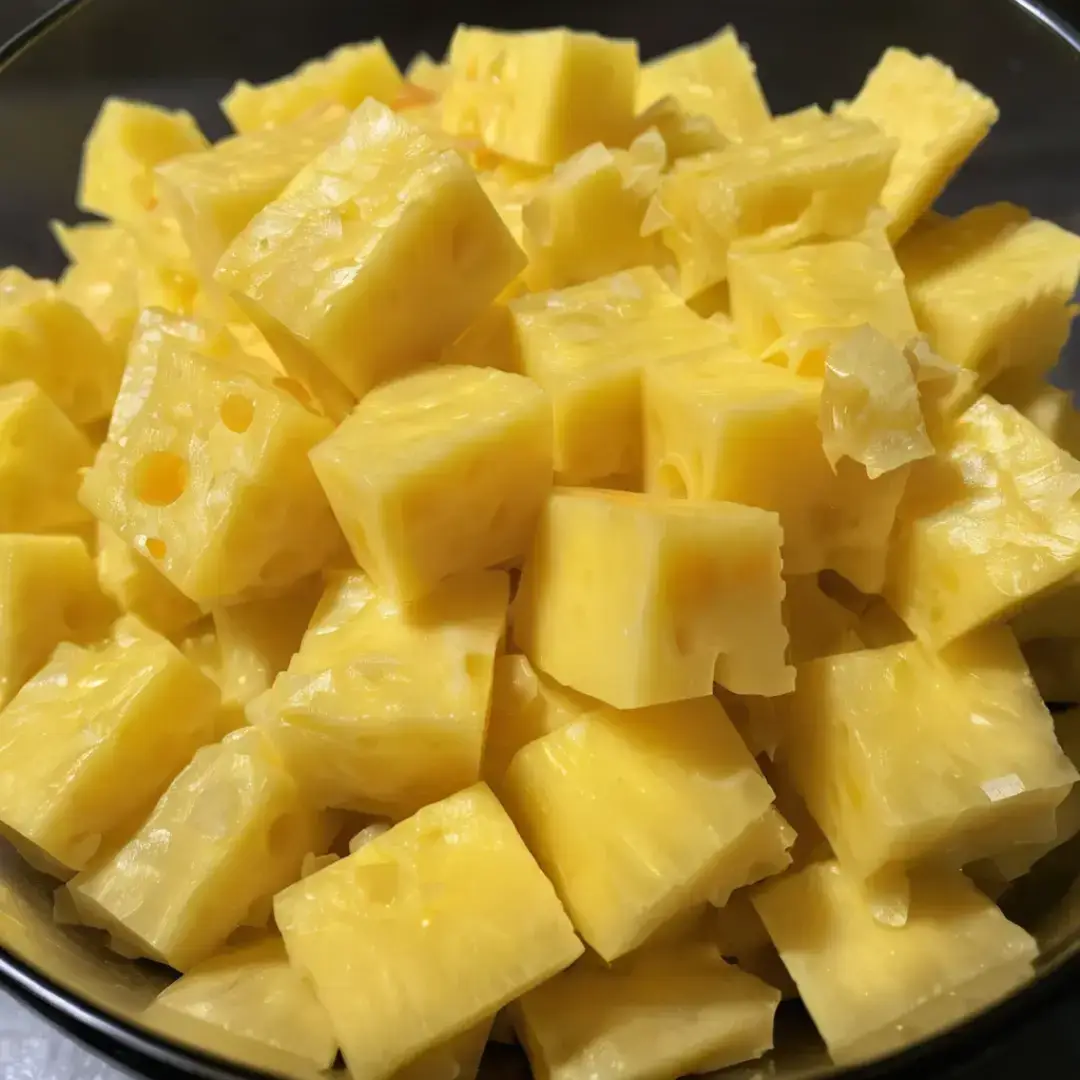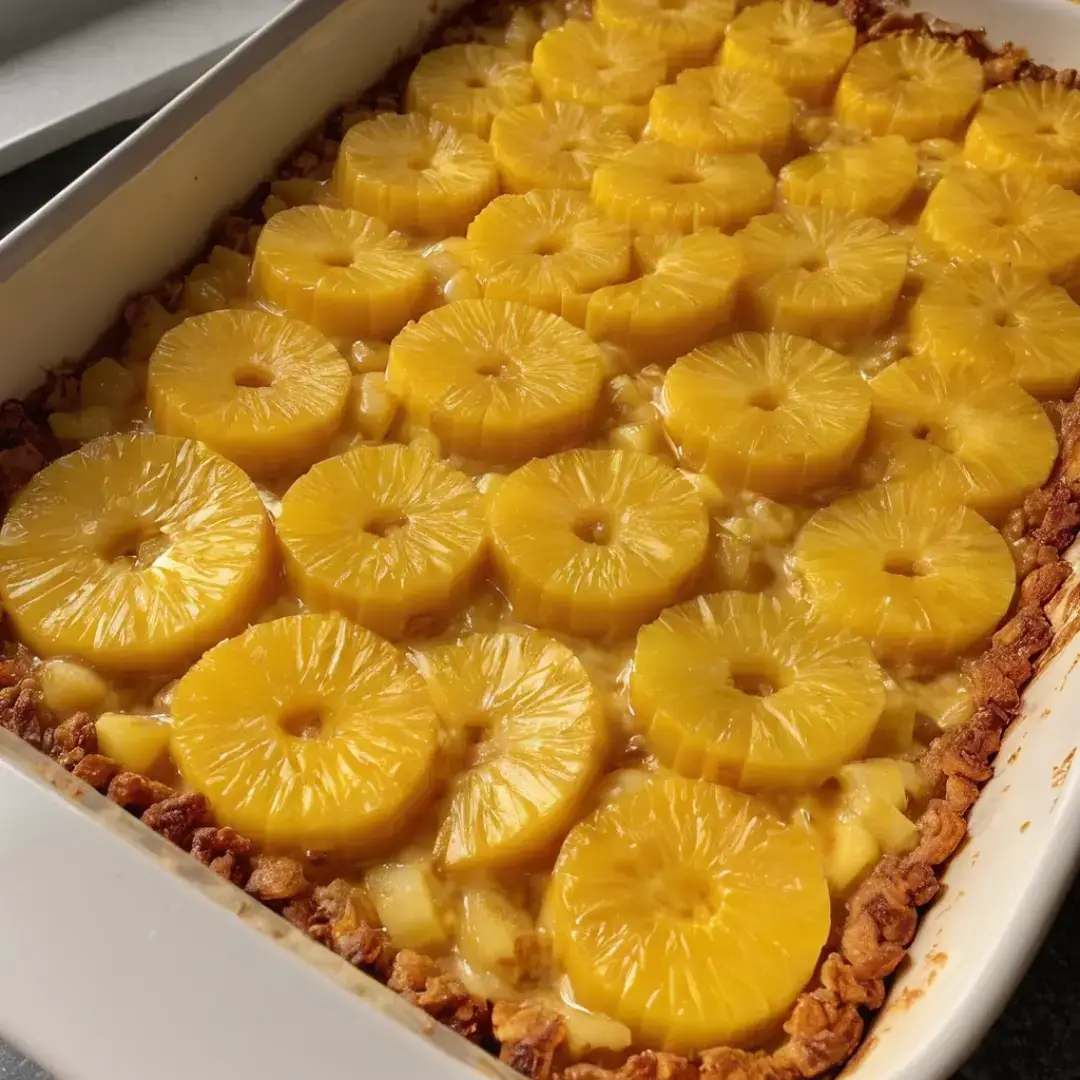If you’ve never tried Pineapple Casserole, get ready to fall in love with a dish that’s equal parts sweet, savory, and completely irresistible! This Southern classic combines juicy pineapple, sharp cheddar cheese, and a buttery cracker topping to create a comforting side dish that’s perfect for holiday gatherings, potlucks, or even a cozy weeknight meal.
At first, the combination might sound unusual—but trust me, one bite and you’ll understand why it’s a favorite in so many households! Whether you’re serving it alongside ham for Easter or as a unique Thanksgiving side, Pineapple Casserole is guaranteed to be a crowd-pleaser.
Why You’ll Love This Recipe
There’s something magical about the combination of flavors in Pineapple Casserole—it’s the perfect balance of sweet, salty, cheesy, and buttery. The juicy pineapple brings a refreshing sweetness, while the melted cheddar adds a creamy, savory contrast. And let’s not forget the crispy, buttery cracker topping that gives every bite a satisfying crunch!
Miranda, the heart behind Milestone Recipes, loves dishes that bring people together, and this Pineapple Casserole does just that. It’s simple to make, requires only a handful of ingredients, and is guaranteed to have your family coming back for seconds. Once you try it, it might just become your new favorite comfort food!
Ingredients for the Perfect Pineapple Casserole
One of the best things about Pineapple Casserole is how simple the ingredients are—you probably have most of them in your kitchen already! Each ingredient plays a key role in balancing the sweet, salty, and buttery flavors that make this dish so irresistible.
For the Filling:
2 (20 oz) cans crushed pineapple, drained (reserve ½ cup juice)
1 cup granulated sugar
½ cup all-purpose flour
2 cups sharp cheddar cheese, shredded
For the Topping:
1 ½ cups crushed butter crackers (like Ritz)
½ cup unsalted butter, melted
Why These Ingredients Work
Crushed pineapple provides the perfect amount of sweetness and juiciness.
Cheddar cheese adds a rich, savory contrast to the pineapple.
Butter crackers give the casserole its signature crispy, buttery topping.
Flour and sugar help thicken the filling and balance the flavors.
With just a few pantry staples, you’ll have everything you need to make the most delicious Pineapple Casserole—a dish that’s comforting, unique, and absolutely unforgettable!

How to Make the Best Pineapple Casserole
Now that you have all your ingredients ready, let’s bring this Pineapple Casserole to life! The process is simple, and in just a few steps, you’ll have a warm, cheesy, buttery dish that’s perfect for any occasion.
Preheat the Oven
Preheat your oven to 350°F (175°C).
Mix the Filling
In a large mixing bowl, combine the drained crushed pineapple, reserved ½ cup of pineapple juice, sugar, flour, and shredded cheddar cheese.
Assemble the Casserole
Pour the pineapple mixture into the prepared baking dish, spreading it out evenly.
Add the Buttery Topping
In a separate bowl, mix the crushed butter crackers with melted butter until fully coated. Sprinkle this mixture evenly over the pineapple filling.
Bake Until Golden
Bake for 25-30 minutes, or until the top is golden brown and crispy. Let the Pineapple Casserole rest for 5 minutes before serving.
This easy, foolproof method ensures that every bite is packed with sweet, savory, and buttery goodness!
Tips for the Best Pineapple Casserole
Want to make sure your Pineapple Casserole turns out absolutely perfect every time? These simple tips will help you get the best balance of flavors and textures!
1. Use Sharp Cheddar for the Best Flavor
The contrast between the tangy pineapple and the rich, sharp cheddar is what makes this dish shine. Mild cheddar works too, but sharp cheddar enhances the savory element of Pineapple Casserole beautifully.
2. Drain the Pineapple Well
Too much liquid can make the casserole soggy. Be sure to drain the crushed pineapple thoroughly, but save ½ cup of juice to keep the filling moist and flavorful.
3. Use Buttery Crackers for Maximum Crunch
Ritz crackers are a classic choice for their rich, buttery flavor. If you prefer a different texture, try crushed pretzels for a salty crunch or panko breadcrumbs for extra crispiness.
4. Don’t Overbake
Bake just until the top is golden brown—about 25-30 minutes. Overbaking can cause the crackers to dry out and lose their buttery richness.
5. Customize It!
Want a twist? Add a pinch of cinnamon for warmth or toss in chopped pecans for added crunch. However you make it, Pineapple Casserole is guaranteed to be a hit!
Serving Suggestions for Pineapple Casserole
Pineapple Casserole is one of those versatile dishes that can be served as a side, a dessert, or even a unique brunch item! Here are some of the best ways to enjoy this sweet and savory favorite.
1. The Perfect Side for Holiday Ham
This dish is a Southern staple at Easter, Thanksgiving, and Christmas, often served alongside glazed ham. The sweet pineapple and tangy cheese perfectly balance the salty richness of the ham, making Pineapple Casserole the ultimate holiday side.
2. Pair It with Fried Chicken or Pork Chops
For a weeknight comfort meal, serve Pineapple Casserole with crispy fried chicken or juicy pork chops. The contrast between the crunchy, buttery topping and the savory meats is pure perfection.
3. Enjoy It as a Sweet Brunch Dish
Think of Pineapple Casserole as a cross between a fruit cobbler and a cheesy gratin. Serve it warm with a dollop of whipped cream or alongside fluffy pancakes and bacon for a sweet and salty brunch option.
No matter how you serve it, Pineapple Casserole adds a unique, comforting touch to any meal!

Recommended Recipes to Pair with Pineapple Casserole
If you love the sweet and savory flavors of Pineapple Casserole, why not build a full meal around it? Here are some delicious recipes from Milestone Recipes that complement this dish beautifully.
1. Spaghetti Casserole Recipe
For a comforting, cheesy meal, pair Pineapple Casserole with a baked spaghetti casserole. The savory, tomato-rich flavors contrast perfectly with the sweet and buttery casserole.
2. Strawberry Banana Pudding
Round out your meal with a light and fruity dessert. The creamy banana pudding with fresh strawberries pairs beautifully with the tropical notes of Pineapple Casserole.
Whether you’re making a holiday spread or a casual family dinner, these dishes will bring out the best in Pineapple Casserole and create a meal everyone will love!
Notes on the Best Pineapple Casserole
Before you start baking, here are a few extra tips to make sure your Pineapple Casserole turns out perfectly every time!
Use fresh pineapple for a twist. While canned crushed pineapple is traditional, you can use finely chopped fresh pineapple for a slightly tangier and brighter flavor. Just make sure to drain any excess juice!
Adjust the sweetness. If you prefer a less sweet Pineapple Casserole, reduce the sugar to ¾ cup or use a sugar substitute like honey.
Make it gluten-free. Swap the all-purpose flour for cornstarch or a gluten-free flour blend. Use gluten-free crackers for the topping, and you’ll have a delicious gluten-free version.
Store leftovers properly. Keep leftover Pineapple Casserole covered in the refrigerator for up to three days. Reheat in the oven at 325°F for 10 minutes to maintain the crispy topping.
Perfect for meal prep. Assemble the casserole ahead of time, cover it, and refrigerate for up to 24 hours before baking.
Follow these notes, and your Pineapple Casserole will be just as delicious as a classic Southern family recipe!
FAQs About Pineapple Casserole
1. Can I use fresh pineapple instead of canned?
Yes! Fresh pineapple works great in Pineapple Casserole, but make sure to finely chop it and drain any excess juice. You may need to add a little extra sugar since fresh pineapple can be more tart than canned.
2. Can I make Pineapple Casserole ahead of time?
Absolutely! Assemble your Pineapple Casserole up to 24 hours in advance, cover it, and store it in the fridge. When you’re ready to bake, add the cracker topping and bake as directed.
3. How do I store leftovers?
Store leftover Pineapple Casserole in an airtight container in the refrigerator for up to three days. Reheat in the oven at 325°F for about 10 minutes to keep the topping crisp.
4. Can I freeze Pineapple Casserole?
Freezing is not recommended, as the texture of the pineapple and cracker topping may change. However, you can freeze the filling separately and add the topping before baking.
5. What cheese works best for Pineapple Casserole?
Sharp cheddar is best because it balances the sweetness of the pineapple. Mild cheddar or a mix of cheddar and Monterey Jack also work well.
6. Is Pineapple Casserole a side dish or a dessert?
It’s both! Many people serve Pineapple Casserole as a side with ham, while others enjoy it as a unique, sweet-savory dessert.
Conclusion
There’s a reason Pineapple Casserole has remained a beloved Southern classic—it’s the perfect combination of sweet, savory, cheesy, and buttery goodness in every bite. Whether you’re serving it as a side dish for a holiday feast, pairing it with a weeknight dinner, or even enjoying it as a unique dessert, this dish always brings warmth and comfort to the table.
For Miranda, this recipe brings back memories of family gatherings where laughter filled the air, and the comforting aroma of Pineapple Casserole baked in the oven. Now, it’s your turn to create those special moments.
So, grab your ingredients, preheat your oven, and get ready to fall in love with this delicious, unexpected dish. Whether you’re introducing it to your family for the first time or carrying on a tradition, Pineapple Casserole is sure to become a favorite. Give it a try—you won’t regret it!
Print
The Best Sweet & Savory Pineapple Casserole
- Total Time: 40 mins
Description
This Pineapple Casserole is the perfect blend of sweet, savory, and buttery goodness! Made with juicy pineapple, sharp cheddar cheese, and a crispy cracker topping, it’s a comforting Southern dish that pairs beautifully with ham, chicken, or even as a unique dessert.
Ingredients
For the Filling:
- 2 (20 oz) cans crushed pineapple, drained (reserve ½ cup juice)
- 1 cup granulated sugar
- ½ cup all-purpose flour
- 2 cups sharp cheddar cheese, shredded
For the Topping:
- 1 ½ cups crushed butter crackers (like Ritz)
- ½ cup unsalted butter, melted
Instructions
- Preheat & Prep: Preheat oven to 350°F and grease a 9×13-inch baking dish.
- Mix the Filling: In a bowl, combine drained pineapple, reserved juice, sugar, flour, and cheddar cheese. Stir well.
- Assemble the Casserole: Pour the pineapple mixture into the baking dish, spreading evenly.
- Prepare the Topping: In a separate bowl, mix crushed crackers with melted butter. Sprinkle over the pineapple mixture.
- Bake: Bake for 25-30 minutes until the topping is golden brown.
- Serve & Enjoy: Let cool slightly before serving warm.
Notes
- For a tangier taste, use fresh pineapple instead of canned.
- Add chopped pecans for extra crunch.
- Serve with holiday ham or fried chicken for the ultimate Southern meal.
- Prep Time: 10 mins
- Cook Time: 30 mins
